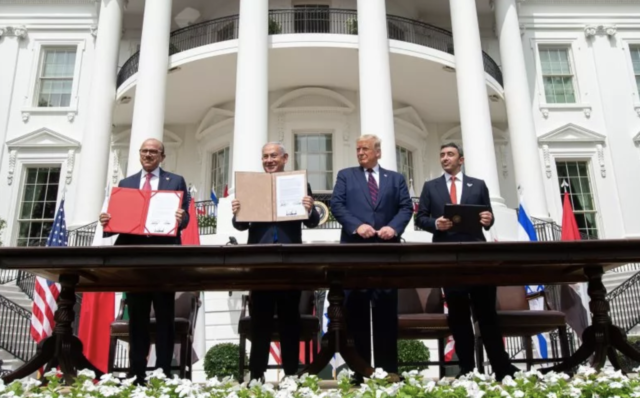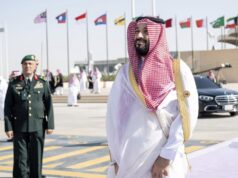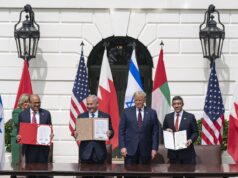In the movie, the WWII commandoes evade the enemy, scale the mountain, enter the fortress, plant the explosives designed to wreck the guns used against Allied forces, and escape to a safe place to watch the effects. But there are no effects, no blast. One team member berates the explosives expert, who calmly replies, “It is the accumulation of little vibrations that does it.” And indeed, in short order – and in the nick of time – the accumulated vibrations crumble the side of the mountain, washing away the guns that threatened the allied advance.
It isn’t always that – sometimes it is Hiroshima and Nagasaki – but the old Middle East appears to be crumbling bit by bit, decision by decision.
Two fundamental propositions underpinned the old Western (read State Department) view of the Middle East: that the Palestinians had to be satisfied before the Arab States could make peace with Israel; and that this was, in large measure, due to the adamant and sometimes violent “Arab Street” that would rise up against conservative Arab leaders if the Palestinians were unsatisfied, or the status of Jerusalem changed.
The move of the U.S. Embassy in Israel to Jerusalem produced hardly a ripple. Resolution of Israel’s Golan border was met with yawns.
President Donald Trump’s “Vision” for Middle East Peace changed the focus from Palestinian demands to Israel’s security – leaving room at the table for the Palestinians, should they accept the invitation and its conditions. The participation of the Ambassadors from the UAE, Oman, and Bahrain in the White House ceremony with the President and Prime Minister Benjamin Netanyahu was a visible vibration, but it followed years of quiet communication and consultation (and trade) between Israel and Gulf States concerned about Iran. Modification in the “Vision,” led to the Abraham Accords between Israel, Bahrain and the UAE, with the U.S. as mediator and witness.
Faster now.
Another invisible vibration was the decision by Saudi Arabia in 2018 to give Air India permission to use its airspace on flights between Delhi and Tel Aviv, and by Sudan to allow Ethiopian Airlines to fly from Addis Ababa to Tel Aviv. The visible formulation allowed Israeli planes to overfly Saudi territory. Not too long ago, some Americans were trying to revive the 1992 Saudi “peace plan” with its mandate for Israel to return to the 1948 armistice lines before negotiations. The question now is whether Saudi Arabia will recognize Israel openly to keep up with the times.
Because the times are moving faster…
Israel and Jordan – peace partners but hardly friends or even friendly – signed an aviation accord last week that will have planes departing from Iraq, Qatar, and Saudi Arabia as well as the UAE to pass through Israeli territory.
Faster still.
Lebanon is having a nervous breakdown under its Hezbollah government. It is bankrupt with no viable sources of national income except, perhaps, one – oil and natural gas off the coast. Israel’s natural gas industry is a matter of public record, but the absence of an agreed maritime border between Israel and Lebanon prevents the Lebanese from participating.
Invisible vibration: knowledgeable observers (involved observers?) note there had been a suggestion, made privately and discussed privately before the Beirut explosion, that Israel would be willing to help Lebanon if Hezbollah could be forced out of the picture. Journalists Nadim Koteich, Rami Nai’m and Makram Rabah, and Former Lebanese minister Sejaan ‘Azzi are out there making the case that, “peace with Israel Is coming no matter what,” as Naim said in an interview.
Visible vibration: Lebanon and Israel will hold direct talks about the border with the U.S. as mediator.
All of which has changed the dynamic in the so-called “Arab Street.” U.S.-based Zogby Analytics found wide support for the normalization of relations with Israel. This month, 59% of Jordanians and Saudis, as well as 58% of Egyptians and 56% of residents of the UAE support normalization, while 61% of Palestinians oppose it. While the UAE Ministry of Strategic Affairs, in its own review, found that social media had a more negative slant, young people across the region want the jobs, technology, and security that cannot come from spending on weapons and ignoring the regional tech generator that is Israel.
We are not done yet.
The metaphorical gun in the island, pointing at Israel and its neighbors, remains the overarching problem of Iran’s pursuit of nuclear weapons capability and the impending lifting of the UN Security Council embargo on the sale of weapons to the Tehran.
But there is an “Iranian Street” as well – which has risen against the government at various points since 2017. The Iranian people should be encouraged, and the Iranian government discouraged by the West as strongly as possible. President Trump’s language on radio last week may have been intemperate, but his vision of regional security matches that of the Sunni Arab States and Israel: the people of Iran and Lebanon need to catch the vibrations of the future.






